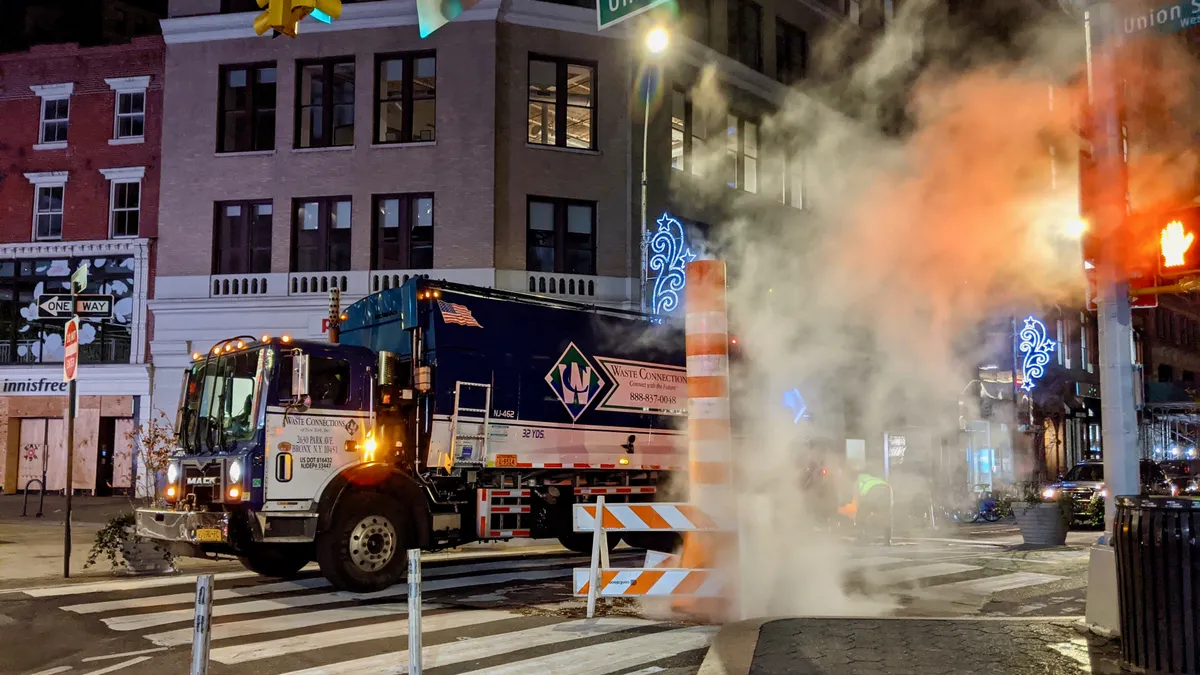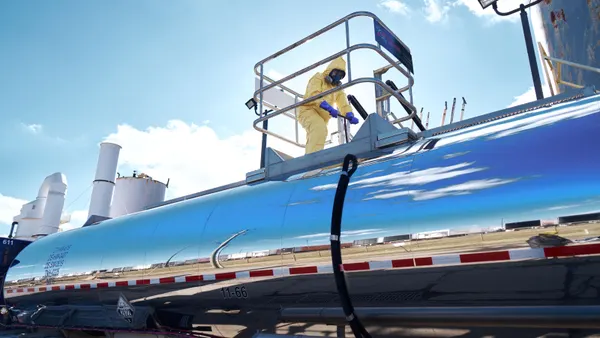2021 Earnings
| Revenue | $6.151B |
| Year-Over-Year Change | 12.95%▲ |
| Net Income | $618M |
Q4 Earnings
| Revenue | $1.624B |
| Year-Over-Year Change | 16.17%▲ |
| Net Income | $166.3M |
Waste Connections exited 2021 on a "high note," according to CEO Worthing Jackman during a Thursday earnings call where it reported sizable growth across multiple business lines and at least the fourth year in a row of major M&A activity. The company spent $1.069 billion on 30 solid waste acquisitions last year, worth an estimated $400 million in annualized revenue.
When combined with deals worth another $100 million of annualized revenue that have already closed this year, such as the acquisitions of Team Waste and assets from Friedman Recycling, Waste Connections could see a 6% revenue boost from M&A alone in 2022. The company also reported $1.01 billion in adjusted free cash flow and said it was managing inflationary, labor and supply-chain constraints through price increases.
Economic updates
- Waste Connections reported core price growth of 5% in the fourth quarter, with increases ranging from 2.6% in some of its exclusive Western franchise markets to as high as 7.2% in more competitive markets. For 2022, executives anticipate solid waste price-plus-volume growth of around 6.5%, mostly led by pricing.
- Solid waste volumes were up 1.2%, with positive trends in all parts of the U.S. Volumes in Canada were also up, but they were down on a reported basis due to the expiration of what Chief Financial Officer Mary Anne Whitney called a "poor quality" municipal contract inherited in the 2016 Progressive Waste Solutions acquisition. Commercial collection and roll-off volumes were up by double-digit percentages, with landfills seeing single-digit percentage growth in all categories.
- Like other waste companies, Waste Connections is still limited by labor availability and has open positions for an estimated 5% of its workforce. During the latest coronavirus surge, it had as many as 1,000 employees out, resulting in it spending an additional $10 million on paid leave and supplemental wages during January.
Waste Connections' earnings call indicates it will continue the measured strategy that has been used to grow from scratch 25 years ago to become the industry's third-largest player.
On the topic of inflation and rising costs to customers, Whitney said "what we’re doing is addressing the environment we’re in, and we think that’s the right way to be proactive from a pricing standpoint." Jackman added that in addition to labor costs rising last year, the inflationary environment is affecting fleet spending, construction and other areas, so pricing must move accordingly.
When asked about the potential to further reduce head count through attrition by investing more in automation — following WM's recent projection that it could shed as many as 7,000 hard-to-fill jobs — Jackman said his company's MRFs are already doing this, but he was more neutral on the concept.
“It’s just called running a good business. We don't talk about what might happen and therefore have expectations and kind of look to the future for something that may or may not be delivered upon," he said. "I don't view this as a layer cake [of] taking thousands of employees out and representing ourselves in a whole different view. The reality is, you chip away and you run a better operation, you try to reduce your reliance on labor in a tough environment, but I wouldn’t hang out hope for something that may sound good but may be more difficult to deliver upon.”
As for the impact of expected interest rate hikes, Whitney said the majority of Waste Connections' debt is fixed, therefore such increases would affect it less than it might other competitors.
"Perhaps for other people, who've relied on the low cost of debt to be more aggressive with respect to acquisitions and other decisions they've made, I think it would have a bigger impact," she said.
Other updates
- Capital expenditures for 2021 were $744.3 million, up 25% from 2020, and the company projects they will potentially be $850 million in 2022. Executives called out plans to spend an estimated $150 million on two new renewable natural gas (RNG) projects at landfills and two new MRFs by the end of 2023.
- The RNG projects are part of a broader list of 15 to 20 sites that could be developed over the next 10 to 15 years. Jackman said about two-thirds of these projects involve outside partners, as seen with a recent announcement by Air Liquide about an Illinois site.
- Waste Connections saw annual recycling revenue more than double, reaching $205 million. Executives said the two greenfield MRF projects will largely optimize the company's current footprint (pending further acquisitions) and will have the latest automated technology. Whitney said the projects are in markets where the company is currently sending material to third-party MRFs, so this will help internalize more volume and take out the risk of processing fees.
- On E&P waste from oil and gas drilling, an area that has been affected by the pandemic, Waste Connections saw business improve during late 2021, but annual revenues of $138.7 million were still below 2020's. While labor availability may be a constraint on drilling activity, executives said volumes could pick up in 2022.
Looking ahead
- First-quarter revenue is projected to be $1.61 billion, with price-plus-volume growth in the solid waste category of about 6.5%. For all of 2022, Waste Connections is projecting revenue of $6.875 billion, adjusted free cash flow of $1.15 billion and net income of $846 million (excluding future acquisitions).
- Waste Connections spent nearly $339 million on stock buybacks and $220 million on dividends in 2021, and it has already spent another $425 million on buybacks this year. Additional activity is possible, though Jackman noted "acquisitions are always more accretive than buying back our stock."
- While M&A spending will inevitably shift at some point, 2022 is poised to be another big year, and Jackman sees up to $4 billion in remaining opportunities. That pipeline could grow further as Waste Connections potentially enters new markets. Jackman called out "owner exhaustion in trying to run a business in a pandemic world" amid ongoing labor and inflationary pressures as a key factor.
- Jackman also said smaller deals would continue to be attractive. "Doing smaller transactions provides a lower risk profile, and a lot better return per capital dollar deployed than doing larger public-to-public type transactions," he said, outlining a potential path to $10 billion in revenue. "What's made us successful [over] the last 25 years will continue to be our playbook going forward."











